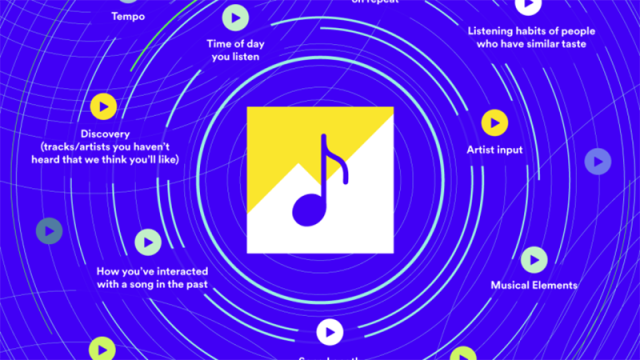As far as big tech media companies go, Spotify’s algorithms have largely avoided scrutiny. But we’re entering a new era for the music streaming giant’s relationship with the algos. People are slowly gaining awareness of Spotify’s potential for emotional surveillance — a model for personality profiling that does for music what Facebook did for friends. And on Monday, the company announced a new initiative that offers artists the chance to pay their way into automated recommendations.
In a carefully worded blog post, Spotify is framing its latest move as a test that will give artists more “input” into the recommendation algorithms that populate personalised playlists with fresh tracks. The company writes that its algorithms take “into account thousands of types of signals: what you’re listening to and when, which songs you’re adding to your playlists, the listening habits of people who have similar tastes, and much more.” Today, Spotify is adding a new signal to the mix: $$$.
Artists uploading new tracks to Spotify will be able to choose “music that’s a priority for them” and in exchange for accepting a “promotional recording royalty rate,” Spotify’s algorithms might just bless them with exposure. The company isn’t making promises, it’s only offering an opportunity. There’s no guarantee of placement in playlists and the reduced royalty rate is only applied to songs that end up being served through the new recommendation system.
What is a “promotional recording royalty rate,” exactly? Spotify did not immediately respond to our request for comment, but a spokesperson for the service told the Verge that they aren’t making the rate public while it’s in testing and Spotify will “calibrate to make sure that the widest group of artists and labels can find success.”
It’s not surprising that Spotify is being extra careful around this subject. Pay-for-play in the radio industry is illegal without disclosing the sponsored nature of a song’s appearance in a normal broadcast. That rules of the web are less clearly defined, but the kind of strategy that Spotify is outlining ensures there’s no direct payment and no guarantee of extra exposure — just some algorithmic hocus pocus until the results start to come in.
The biggest short-term risk is that this approach causes more damage to the relationship between Spotify and musicians. A new campaign finds the Union of Musicians and Allied Workers calling on the company to pay artists at least $US0.01 ($0) per stream of a song. Spotify doesn’t list its artist payment rates, but analysts have found that it comes out to about $US0.00318 per stream.
And, sure, let’s not leave out the possibility that artists use this service, like it, and everyone wins. But it’s still an ominous sign that Spotify is experimenting with methods that, by their nature, make recommendations less organic.
